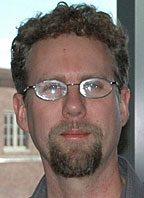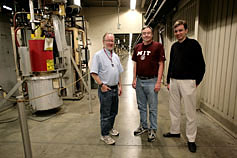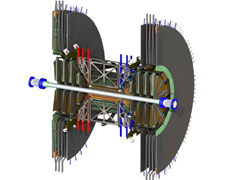| Research
|
It's not surprising that one of Dr. Karl Mueller's favorite science fiction authors is William Gibson, who coined the term “cyberspace” and writes about the influence of technology on humans. Mueller, associate professor of chemistry at Penn State University, is using technology to do some influencing of his own. Mueller, a physical chemist, is known for developing and applying solid-state nuclear magnetic resonance, or NMR, to attack problems in materials and environmental sciences. Since1999, his work for DOE has increased understanding about the reactions and transport of elements like strontium in Cold War legacy waste. He and his collaborators are making significant contributions to a nationwide cyberkinetics database, co-funded by DOE and the National Science Foundation. The work addresses some of the nation's most challenging problems in remediation, element cycling and pollution control. One of Mueller's most powerful tools is the 900 megahertz NMR system at DOE's Environmental Molecular Sciences Laboratory, a BER national scientific user facility at Pacific Northwest National Laboratory . Since 2002, Mueller and his graduate students have been using the system to investigate chemical reactions at the atomic level. For cyberspace fan Mueller, there's an added bonus: He and his students can operate the NMR from their desktop computers at Penn State . First, they ship the material samples to EMSL, where researchers place them in the NMR magnet and tune the probe. Then Mueller's team logs onto a secure Internet connection to operate the equipment and collect data. The capabilities of the NMR and EMSL research staff are unparalled nationwide, according to Mueller. “Some of the data we can get in three days at EMSL would have taken more than two years to acquire with the equipment at Penn State ,” he said. In cyberspace and on the ground, Mueller's work is helping reduce the nation's environmental risks. Submitted by DOE's Pacific Northwest National Laboratory |
|||||||||||||||||||||||
|
Check out the Office of Science's new Website.
|
Los Alamos/Brookhaven collaboration lands funds to start detector constructionPhysicists at DOE's Los Alamos National Laboratory working for six years on the design and development of a new forward silicon vertex detector upgrade (FVTX) for the Pioneering High-Energy Nuclear Interaction Experiment (PHENIX) experiment at Brookhaven National Laboratory's Relativistic Heavy Ion Collider (RHIC) recently learned that the $5M upgrade for a construction start is in next year's budget.
The FVTX detector is designed to detect particles from heavy ion and proton-proton collisions and determine the direction from which they arrive. The detector will house roughly 6500 square centimeters of silicon strip detectors, comprising 1.1 million strips and 8640 custom integrated circuits. Addressing the fundamental question of where the proton gets its spin, the FVTX detector upgrade will open the door to new physics studies of the so-called "perfect liquid", a new state of matter recently discovered at RHIC. FVTX is designed specifically to detect and identify heavy quarks, charm and beauty. As heavy quarks traverse the device's liquid medium, they can be used to probe the detailed characteristics of this new state of matter. The FVTX detector work is actually part of an even larger collaborative effort between Los Alamos physicists and their colleagues from the University of New Mexico and New Mexico State University, who are leading the spin physics effort at RHIC using the LANL-built muon spectrometers. The spin team's simulation efforts have determined that the FVTX detector will be able to provide improved polarization measurements for heavy quark production over what can be obtained with the existing PHENIX detectors. As the only polarized proton-proton collider facility in the world, Brookhaven's RHIC is the flagship accelerator facility of DOE's Office of Science - Office of Nuclear Physics. The detector project is supported by the Medium Energy Program and the Heavy Ion Program in DOE's Office of Nuclear Physics. Submitted by DOE's Los Alamos National Laboratory |



